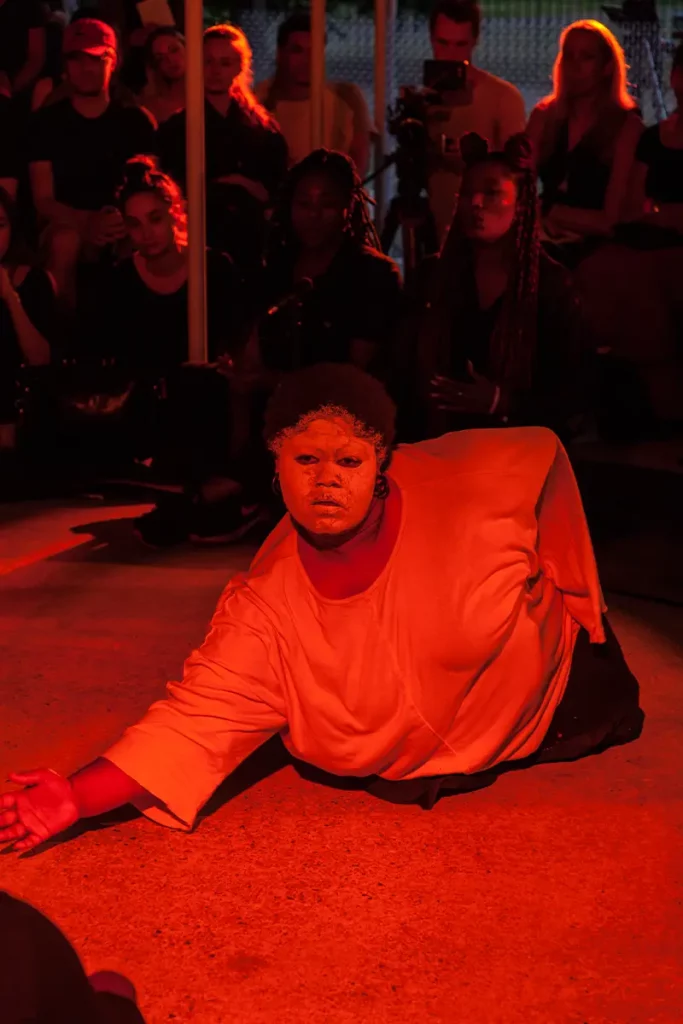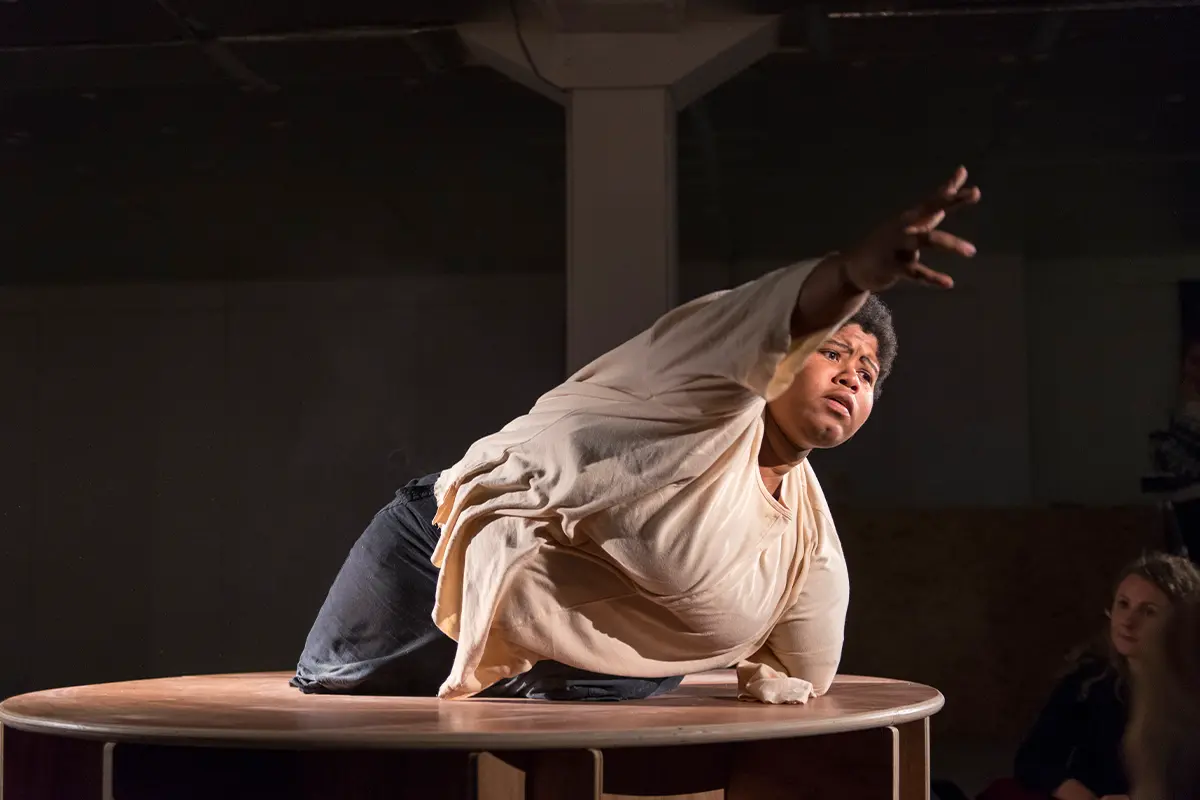Multi-disciplinary artist Shawanda Corbett discusses cyborg theory, ceramic, jazz music, performance and her latest exhibition Let the Sunshine In
Shawanda Corbett is a rebel. An interdisciplinary artist whose career spans ceramic, performance, painting and poetry, Corbett brings her perspective as a woman of color with a differently-abled body to root Donna Haraway’s A Cyborg Manifesto into reality. Born without legs and an arm, Corbett defines herself as a cyborg artist, reframing the preconceived notions surrounding gender, race and body.
Shawanda Corbett on music as a guiding force
Corbett’s artistic practice begins with music. Living between New York and Mississippi, she finds the musical culture of the American South, specifically jazz, to be one of the driving forces that weaves her ceramics and performances together. Corbett explains that, «Everything that I do, starts from music. Every show has a different list of inspirations, it’s kind of a recording of what’s going on in the present time. Music is a stamp of the moment, which dictates how I make the work, how I respond to whatever the clay wants to be. But also, how the performance is going to be, how that is set up».
Whether in celebratory get-togethers, in conversations or in the stories elders would tell the younger generations, «In Mississippi, it was very music driven, music was part of everything. It’s how we communicate». The liberating force of jazz allowed Corbett to translate her heritage in the creation of free-flowing organic forms. As if entering a state of meditation, music controls «how fast I make the work, the shape and it lets me know how much weight it can bear, how tall it can be. Even though it is structurally sound, I can tell it wants to be shorter or taller and I respond to that».
Body and clay on Shawanda Corbett’s work
When asked what attracted Corbett to explore the medium of clay, she explains that «it was the challenge». Though clay carries the ability of being malleable, presenting the possibility of discovering limitless shapes, it also brings forward physical challenges, creating a power struggle. But for Corbett, the combination of body and clay, with the dynamic fluidity of jazz, transforms the vessels to become extensions of herself. As if entering a meditative state, Corbett responds to the direction clay wants to go.
Drawing inspiration from Japanese and Western African ceramic traditions, Corbett tilts individual bodies of clay, releasing the energy and memory of the earth to create fluid individual forms, each reminiscent of the people she encountered in her life. «In Western ceramics they teach you how to get the memory out, in order to make it the way you want it to. But in different places in Asia, especially Japan, their philosophy around ceramics is completely different and they understand that they could make everything, but they find the best clay body to do that with. Their way of doing it definitely challenged me to just listen to the clay. It definitely undid a lot of the training I did in school».
Before Corbett starts the ceramic vessels, she first completes the paintings that will be placed on their surfaces, creating representations of people who have surrounded her life. She then carefully picks ceramic vessels that best capture the essence of that person. Each filled with different colors and shapes, some are tilted and bent, almost holding the posture of the characters.
Her intention to encapsulate individual personas in her sculptures, comes as a reaction towards the stereotypical perception the mainstream media has created around the people present in her communities, who are predominately people of color, «It was more of a response to what media has created, stereotypes of what these people are like, what kind of life they live, what their moral and values are, just by the things they do that is deemed as not upstanding to the community. It’s more of the essence of who they are and how I remember them in that time».

Shawanda Corbett and the ancient Greek theater
Corbett responds to the environment her work is displayed in. In her exhibitions, she positions the vessels closer to the ground, where she would normally see them. She follows a similar approach in her performances where she invites the audience to sit on the ground, allowing them to experience her dance from the same visual perspective. «I come at it from different angles. It’s very three-dimensional, so it’s not just one point of view or one way of shaping. I look at it from all the way around».
Building on her heritage, Corbett creates a new world where people can find stories of the past, as well as approach the space to find something within themselves. «It is all of those things, a sub-conscious make-believe place but also it’s a real place where we all tend to go when we feel stressed, distracted, even in dreams. But it is also a touch of reality on what is going on».
Weaving a dialogue between ceramic vessels and performance, Corbett references the Ancient Greek theatre, where ceramics were used to document performances and historical events. Responding to the spaces surrounding her, her performative work explores themes under Black history, culture, sexuality, gender and body politics.
In Evocation of Buked (2018), she displays a live performance, examining the biblical and social implications of disability during slavery. Exploring the experiences of undocumented disabled female slaves in post-colonial Mississippi, she captures their international dialogue with God. In another performance, titled breathe (2020), Corbett calls to attention the Black experience, highlighting the politicization of the Black body that begins from birth, as the first breath is taken in.
Shawanda Corbett: a cyborg manifesto
Breaking the preconceived notions on how society perceives differently-abled communities, Corbett defines herself as a cyborg artist. Drawing inspiration from Donna Hathaway’s A Cyborg Manifesto (1985), she believes that anything mechanical that enhances one’s life makes them a cyborg.
«I define it as anything mechanical that enhances one’s life. For a lot of people, it’s a phone or transportation or just anything mechanical that doesn’t necessarily have to be part of artificial intelligence but could be made by it as well. It’s very broad and it includes a lot of people, most people I would stay. For me, I didn’t necessarily like having the identity of disabled, because it has a lot of political and social attachments to it. That’s why I prefer the cyborg identity».
In her manifesto, Donna Haraway claimed that increasing human dependence on machines and a mechanized way of living would ultimately lead people to reject the rigid boundaries natural and cultural identifications have created in people’s lives, paving the way for the creation of cyborgs who will build their own conditions for existence. Building on the manifesto, Corbett believes that Haraway’s theory comes with missing pieces, especially for women of color and differently-abled communities.
«With her manifesto, although it was good, there was a lot of terminology that was used in the medical field for disabled people. Even though she expressed it for women, it wasn’t for all women. Even though she tried to make other references to lightly touch on different people of color, I just didn’t agree with it. I guess it was a reflection of the time. What I wanted to do was to expand and redefine that and really talk about a lot of things that were missed within her manifesto. I wanted to talk about the fact that there is a social practice but there is the actual reality of that theory. How do these things actually affect communities?»
AI (artificial intelligence), augmented reality, metaverse, cyborgs are topics of much discussion at the present time. The relationship AI manufacturing companies have developed with differently-abled people pushed Corbett to question the ethics that lie behind the intentions of these tool-makers. «In relation to AI, you know that the community (differently-abled) was used a lot as guinea pigs to advance AI because it has to be experimented on by someone». She calls into question AI’s promise for inclusivity and argues that firms presume the response different communities would give to the changes brought by AI, rather than examining how they would actually react in reality.
Complete Body – Shawanda Corbett
Corbett relates the manifesto to the question of what is a complete body. She uses her perspective as a woman of color with a differently-abled body to base the theory into reality. Whether it be from a biological point of view, mentally or from the perspective of a cyborg, for Corbett the desire to explore the notion of completeness «came from the social reaction to what my body looks like. Whether it seems incomplete or not, it is a complete body. The different metamorphosis the body naturally makes is a complete body. Even when you think mentally, what is the actual standard for mental health? We all project our own idea on what a stable mind is, but it is still a complete body. Just the conditioning of the physical and mental body, the social and political bodies… we think that any defect that may arise makes it incomplete. But it is always complete. We need to change that mentality».
In her exhibition Let the Sunshine In, which was shown at Tate Britain, Corbett presented her first short film titled Cyborg theory: the adequacy of tenderness to our antipathy which dived into the cyborg theory and questioned the ethics behind AI, through documenting a person’s day and their interaction with the spaces they inhabit. «We had 8 scenes, each being a block of time. So, it is 24 hours, but from the point of view of a black person’s life, because that’s the point of view I can give you. It’s the duality between reality but also internally. A dream-state, a disassociation, a survival but hopefulness. It goes through stages. It is all directed from the music I scored».
The exhibition Let the Sunshine In
Showcasing a short-film accompanied by a jazz score, the exhibition also presents a new set of ceramic vessels which reevaluate gender and racial stereotypes. Curated by Bilal Akkouche and Hannah Marsh, the title of the exhibition comes from 1960s American band the 5th Dimension’s song Aquarius/Let the Sunshine In.
«Let the Sunshine In is about the journey of self-love which no one really talks about in the way of pain. We are so eager to quickly heal the pain without really understanding it. But it’s okay to be in those places and that’s when we lock ourselves up, until we heal and present ourselves again to the world. But it’s all about connecting those emotions and to say you are enough».
Throughout her artistic career, Corbett explores various themes around her heritage, politics which revolve around her body and race, as well as raising questions on the course of the future. But at the end of her performances, she would like the audience to leave with the understanding that, «They too are enough; we all have an idea of how we should live our life and I don’t necessarily start with how things physically look. I connect these different topics and conversations with feelings, and that’s something we all share. Emotion is a language and you have to be flexible with that, speak different emotional languages. Challenge what we think of happiness and sadness. I always work in the in-betweens and those things resonate differently depending on the location, I am very mindful of that. It’s really about how you see yourself».
Shawanda Corbett
Shawanda Corbett is an American multi-disciplinary artist whose practice spans ceramics, performance, dance, poetry and visual art. Born in 1989, Corbett spent most of her life between New York and Mississippi. She holds a BFA in ceramics and printmaking, with a minor in theater from Rochester Institute of Technology and a MFA from the Ruskin School of Art at the University of Oxford.



















